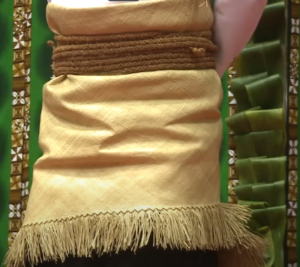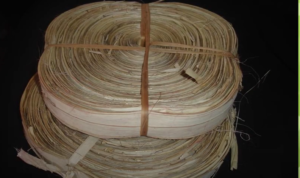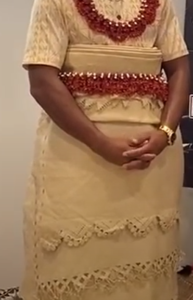Tongan culture is rich in tradition, with clothing playing a significant role in expressing identity, heritage, and respect.
Among the most iconic items of Tongan attire are the ta‘ovala and kiekie.
These garments go beyond fashion; they symbolize status, tradition, and community values.
Let’s take a closer look at these beautiful and meaningful pieces.

Overview of the Ta‘ovala and Kiekie
The ta‘ovala is a fine mat worn around the waist, typically secured with a braided cord known as a kafa.
Having historical significance, it is seen as a symbol of respect and humility. The kiekie, on the other hand, is a decorative and functional accessory. Worn mostly by women, it resembles a belt-like adornment that falls elegantly around the waist and hips.
Both garments reflect Tongan artistry, blending natural materials with cultural meaning.
Ta‘ovala: The Cultural Significance
The history of the ta‘ovala is linked to Tongan mythology. Legend has it that an early ancestor wore mats to cover their bodies upon arriving at the Tongan islands, signifying respect for the land. Today, the ta‘ovala carries this legacy, being an essential adornment for ceremonies, religious events, and official occasions. Its significance lies not only in tradition but also in its representation of Tongan pride and dignity.
Both men and women wear the ta‘ovala, with styles and details varying based on the occasion. Its intricate weaving and natural texture often make it distinguishable. Learn more about how Tongan culture has preserved the tradition of the ta‘ovala.
Kiekie: Design and Materials
Made from materials like hibiscus bark, pandanus leaves, and coconut husk, kiekies are worn by women and are visually appealing.
Designs range from simple patterns to elaborate creations incorporating shells, beads, or feathers.
Kiekies are particularly popular for their versatility. They suit both formal and casual settings.
Modern designs even blend traditional materials with contemporary styles, as highlighted in the Coconet TV feature on kiekie’s fashionable adaptations.

Crafting Techniques
The craftsmanship behind the ta‘ovala and kiekie showcases the resourcefulness and creativity of Tongan artisans. Passed down through generations, these techniques reflect a deep connection to nature and culture.
Materials Used in Ta‘ovala Production
Ta‘ovalas are typically crafted using finely woven pandanus leaves. The leaves are beaten and dried to achieve a specific texture and color.
Adding to its complexity, some ta‘ovalas incorporate coconut fibers or fine mats known as ngatu.
These natural elements emphasize eco-friendly fashion while maintaining cultural authenticity.
The weaving process illustrates how Tongan craftspeople balance precision and artistry. Each piece carries hours of work, making it invaluable both culturally and economically.

Kiekie Weaving Process
The kiekie weaving process begins with collecting and preparing natural fibers. Hibiscus bark or pandanus leaves are stripped, softened, and dyed if necessary. The fibers are then woven into intricate patterns or knotted to create decorative fringes. Some kiekie pieces include imported accents like faux pearls or mother-of-pearl, blending tradition with modern flair.
This weaving tradition showcases women’s craftsmanship and adaptability. Designs can be personalized, reflecting the wearer’s social standing or the event’s significance.
Occasions for Wearing Ta‘ovala and Kiekie
Both the ta‘ovala and kiekie are not just everyday wear but also for special moments that connect individuals to their community, faith, and family.
Ta‘ovala in Ceremonial Contexts
The ta‘ovala is most commonly worn during formal events such as weddings, funerals, or royal ceremonies.
Its presence signifies respect for the occasion and the people involved.
Church services and community meetings also see the widespread use of ta‘ovala and the kiekie.
For Tongans living outside their homeland, wearing a ta‘ovala can be a way to honor their roots.
For example, graduation time is when most Tongan abroad will be wearing their traditional attire to honor their roots.

Conclusion
The ta‘ovala and kiekie are windows into Tongan culture, blending tradition with identity. As expressions of respect, creativity, and community values, these garments stand the test of time, uniting generations through their shared meaning. From handcrafted techniques to modern adaptations, they tell a story of heritage and resilience.
Whether worn for ceremonial purposes or styled as a contemporary accessory, the ta‘ovala and kiekie continue to honor the past while shaping the present. They remind us of the beauty in preserving tradition amidst a world of change.
Book your stay at Hotel Nuku’alofa today and make your journey into Tongan culture unforgettable.
Visit the bustling market near Hotel Nuku’alofa, located in the heart of the business district.
Here, you can marvel at these exquisite creations up close and perhaps even bring one home as a treasured souvenir.
With comfort, convenience, and culture at your doorstep, there’s no better place to stay while exploring the wonders of Tonga.
